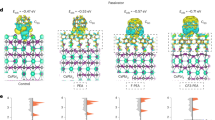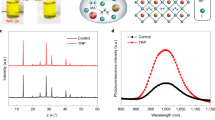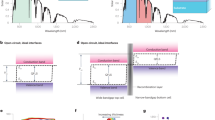Abstract
Halide segregation critically limits the stability of mixed-halide perovskite solar cells under device operational conditions. There is a strong indication that halide oxidation is the primary driving force behind halide de-mixing. To alleviate this problem, we develop a series of multifunctional redox mediators based on anthraquinone that selectively reduce iodine and oxidize metallic Pb0, while simultaneously passivating defects through tailored cationic substitution. These effects enable wide-bandgap perovskite solar cells to achieve a power conversion efficiency of 19.58% and a high open-circuit voltage of 1.35 V for 1.81-eV PSCs. The device retains 95% of its initial efficiency after operating at its maximum power point for 500 h. Most notably, by integrating the perovskite device into the monolithic perovskite-organic tandem solar cell as a wide-bandgap subcell, we report an efficiency of 25.22% (certified 24.27%) with impressive long-term operational stability (T90 > 500 h).
This is a preview of subscription content, access via your institution
Access options
Access Nature and 54 other Nature Portfolio journals
Get Nature+, our best-value online-access subscription
$29.99 / 30 days
cancel any time
Subscribe to this journal
Receive 12 digital issues and online access to articles
$119.00 per year
only $9.92 per issue
Buy this article
- Purchase on Springer Link
- Instant access to full article PDF
Prices may be subject to local taxes which are calculated during checkout





Similar content being viewed by others
Data availability
All data generated or analysed during this study are included in the published Article and its Supplementary Information and Source Data files. Source data are provided with this paper.
References
Kim, J. Y. et al. Efficient tandem polymer solar cells fabricated by all-solution processing. Science 317, 222–225 (2007).
Shockley, W. & Queisser, H. J. Detailed balance limit of efficiency of p‐n junction solar cells. J. Appl. Phys. 32, 510–519 (1961).
McMeekin, D. P. et al. A mixed-cation lead mixed-halide perovskite absorber for tandem solar cells. Science 351, 151–155 (2016).
Tockhorn, P. et al. Nano-optical designs for high-efficiency monolithic perovskite–silicon tandem solar cells. Nat. Nanotechnol. 17, 1214–1221 (2022).
Chen, H. et al. Regulating surface potential maximizes voltage in all-perovskite tandems. Nature 613, 676–681 (2023).
Brinkmann, K. O. et al. Perovskite–organic tandem solar cells with indium oxide interconnect. Nature 604, 280–286 (2022).
Kojima, A., Teshima, K., Shirai, Y. & Miyasaka, T. Organometal halide perovskites as visible-light sensitizers for photovoltaic cells. J. Am. Chem. Soc. 131, 6050–6051 (2009).
Wu, S., Liu, M. & Jen, A. K.-Y. Prospects and challenges for perovskite-organic tandem solar cells. Joule 7, 484–502 (2023).
Yang, H. et al. Regulating charge carrier recombination in the interconnecting layer to boost the efficiency and stability of monolithic perovskite/organic tandem solar cells. Adv. Mater. 35, 2208604 (2023).
Chen, W. et al. Monolithic perovskite/organic tandem solar cells with 23.6% efficiency enabled by reduced voltage losses and optimized interconnecting layer. Nat. Energy 7, 229–237 (2022).
Hoke, E. T. et al. Reversible photo-induced trap formation in mixed-halide hybrid perovskites for photovoltaics. Chem. Sci. 6, 613–617 (2015).
Barker, A. J. et al. Defect-assisted photoinduced halide segregation in mixed-halide perovskite thin films. ACS Energy Lett. 2, 1416–1424 (2017).
Slotcavage, D. J., Karunadasa, H. I. & McGehee, M. D. Light-induced phase segregation in halide-perovskite absorbers. ACS Energy Lett. 1, 1199–1205 (2016).
Abdi-Jalebi, M. et al. Maximizing and stabilizing luminescence from halide perovskites with potassium passivation. Nature 555, 497–501 (2018).
Xu, J. et al. Triple-halide wide-band gap perovskites with suppressed phase segregation for efficient tandems. Science 367, 1097–1104 (2020).
Al-Ashouri, A. et al. Monolithic perovskite/silicon tandem solar cell with >29% efficiency by enhanced hole extraction. Science 370, 1300–1309 (2020).
Zhao, Y. et al. Strain-activated light-induced halide segregation in mixed-halide perovskite solids. Nat. Commun. 11, 6328 (2020).
Tian, L., Xue, J. & Wang, R. Halide segregation in mixed halide perovskites: visualization and mechanisms. Electronics 11, 700 (2022).
Draguta, S. et al. Rationalizing the light-induced phase separation of mixed halide organic–inorganic perovskites. Nat. Commun. 8, 200 (2017).
Bischak, C. G. et al. Tunable polaron distortions control the extent of halide demixing in lead halide perovskites. J. Phys. Chem. 9, 3998–4005 (2018).
Knight, A. J. et al. Electronic traps and phase segregation in lead mixed-halide perovskite. ACS Energy Lett. 4, 75–84 (2019).
Kerner, R. A., Xu, Z., Larson, B. W. & Rand, B. P. The role of halide oxidation in perovskite halide phase separation. Joule 5, 2273–2295 (2021).
Samu, G. F. et al. Electrochemical hole injection selectively expels iodide from mixed halide perovskite films. J. Am. Chem. Soc. 141, 10812–10820 (2019).
Frolova, L. A. et al. Reversible Pb2+/Pb0 and I−/I3− redox chemistry drives the light-induced phase segregation in all-inorganic mixed halide perovskites. Adv. Energy Mater. 11, 2002934 (2021).
Xu, Z. et al. Halogen redox shuttle explains voltage-induced halide redistribution in mixed-halide perovskite devices. ACS Energy Lett. 8, 513–520 (2023).
DuBose, J. T. & Kamat, P. V. Hole trapping in halide perovskites induces phase segregation. Acc. Mater. Res. 3, 761–771 (2022).
Mathew, P. S., Samu, G. F., Janáky, C. & Kamat, P. V. Iodine (I) expulsion at photoirradiated mixed halide perovskite interface. Should I stay or should I go? ACS Energy Lett. 5, 1872–1880 (2020).
Wang, L. et al. A Eu3+-Eu2+ ion redox shuttle imparts operational durability to Pb-I perovskite solar cells. Science 363, 265–270 (2019).
Steirer, K. X. et al. Defect tolerance in methylammonium lead triiodide perovskite. ACS Energy Lett. 1, 360–366 (2016).
Grätzel, M. Dye-sensitized solar cells. J. Photochem. Photobiol. 4, 145–153 (2003).
Jiang, Q. et al. Surface passivation of perovskite film for efficient solar cells. Nat. Photon. 13, 460–466 (2019).
Chen, B., Rudd, P. N., Yang, S., Yuan, Y. & Huang, J. Imperfections and their passivation in halide perovskite solar cells. Chem. Soc. Rev. 48, 3842–3867 (2019).
Huskinson, B. et al. A metal-free organic–inorganic aqueous flow battery. Nature 505, 195–198 (2014).
Mourad, E. et al. Biredox ionic liquids with solid-like redox density in the liquid state for high-energy supercapacitors. Nat. Mater. 16, 446–453 (2017).
Cai, C.-Y. et al. Photoelectrochemical asymmetric catalysis enables site- and enantioselective cyanation of benzylic C–H bonds. Nat. Catal. 5, 943–951 (2022).
Lin, K. et al. Alkaline quinone flow battery. Science 349, 1529–1532 (2015).
Vanysek, P. Electrochemical series. CRC Handb. Chem. Phys. 8, 8–33 (2000).
Lin, Y.-H. et al. A piperidinium salt stabilizes efficient metal-halide perovskite solar cells. Science 369, 96–102 (2020).
Jo, Y. et al. High performance of planar perovskite solar cells produced from PbI2(DMSO) and PbI2(NMP) complexes by intramolecular exchange. Adv. Mater. Interfaces 3, 1500768 (2016).
Xiao, K. et al. Scalable processing for realizing 21.7%-efficient all-perovskite tandem solar modules. Science 376, 762–767 (2022).
Xiao, K. et al. All-perovskite tandem solar cells with 24.2% certified efficiency and area over 1 cm2 using surface-anchoring zwitterionic antioxidant. Nat. Energy 5, 870–880 (2020).
Beal, R. E. et al. Structural origins of light-induced phase segregation in organic-inorganic halide perovskite photovoltaic materials. Matter 2, 207–219 (2020).
Tan, S. et al. Surface reconstruction of halide perovskites during post-treatment. J. Am. Chem. Soc. 143, 6781–6786 (2021).
Zhao, L. et al. Redox chemistry dominates the degradation and decomposition of metal halide perovskite optoelectronic devices. ACS Energy Lett. 1, 595–602 (2016).
Li, Y. et al. Light-induced degradation of CH3NH3PbI3 hybrid perovskite thin film. J. Phys. Chem. C 121, 3904–3910 (2017).
McGettrick, J. D. et al. Sources of Pb(0) artefacts during XPS analysis of lead halide perovskites. Mater. Lett. 251, 98–101 (2019).
Guo, Y. et al. Phenylalkylammonium passivation enables perovskite light emitting diodes with record high-radiance operational lifetime: the chain length matters. Nat. Commun. 12, 644 (2021).
Saidaminov, M. I. et al. Multi-cation perovskites prevent carrier reflection from grain surfaces. Nat. Mater. 19, 412–418 (2020).
Jiang, Q. et al. Compositional texture engineering for highly stable wide-bandgap perovskite solar cells. Science 378, 1295–1300 (2022).
Bu, T. et al. Lead halide-emplated crystallization of methylamine-free perovskite for efficient photovoltaic modules. Science 372, 1327–1332 (2021).
Deng, X. et al. Co-assembled monolayers as hole-selective contact for high-performance inverted perovskite solar cells with optimized recombination loss and long-term stability. Angew. Chem. Int. Ed. 61, e202203088 (2022).
Almora, O. et al. Quantifying the absorption onset in the quantum efficiency of emerging photovoltaic devices. Adv. Energy Mater. 11, 2100022 (2021).
Wu, X., Li, B., Zhu, Z., Chueh, C.-C. & Jen, A. K. Y. Designs from single junctions, heterojunctions to multijunctions for high-performance perovskite solar cells. Chem. Soc. Rev. 50, 13090–13128 (2021).
Xie, Y.-M. et al. Homogeneous grain boundary passivation in wide-bandgap perovskite films enables fabrication of monolithic perovskite/organic tandem solar cells with over 21% efficiency. Adv. Funct. Mater. 32, 2112126 (2022).
Qin, S. et al. Constructing monolithic perovskite/organic tandem solar cell with efficiency of 22.0% via reduced open-circuit voltage loss and broadened absorption spectra. Adv. Mater. 34, 2108829 (2022).
Zeng, Q. et al. A two-terminal all-inorganic perovskite/organic tandem solar cell. Sci. Bull. 64, 885–887 (2019).
Lang, K. et al. High performance tandem solar cells with inorganic perovskite and organic conjugated molecules to realize complementary absorption. J. Phys. Chem. Lett. 11, 9596–9604 (2020).
Li, Z. et al. Hybrid perovskite-organic flexible tandem solar cell enabling highly efficient electrocatalysis overall water splitting. Adv. Energy Mater. 10, 2000361 (2020).
Chen, X. et al. Efficient and reproducible monolithic perovskite/organic tandem solar cells with low-loss interconnecting layers. Joule 4, 1594–1606 (2020).
Wang, P. et al. Tuning of the interconnecting layer for monolithic perovskite/organic tandem solar cells with record efficiency exceeding 21%. Nano Lett. 21, 7845–7854 (2021).
Acknowledgements
We thank Y. An and H.-L. Yip from City University of Hong Kong for conducting the optical simulation, and Nano-X from Suzhou Institute of Nano-Tech and Nano-Bionics, Chinese Academy of Sciences (SINANO) for technical support. A.K.-Y.J. is thankful for the sponsorship of the Lee Shau-Kee Chair Professor (Materials Science) and support from APRC grants from the City University of Hong Kong (9380086, 9610419, 9610492 and 9610508), a TCFS grant (GHP/018/20SZ), an MRP grant (MRP/040/21X) from the Innovation and Technology Commission of Hong Kong, the Green Tech Fund (202020164) from the Environment and Ecology Bureau of Hong Kong, GRF grants (11307621 and 11316422) from the Research Grants Council of Hong Kong, Shenzhen Science and Technology Program (SGDX20201103095412040), Guangdong Major Project of Basic and Applied Basic Research (2019B030302007), Guangdong-Hong Kong-Macao Joint Laboratory of Optoelectronic and Magnetic Functional Materials (2019B121205002), Guangzhou Huangpu Technology Bureau (2022GH02) and a CRF grant (C6023-19GF) from the Research Grants Council of Hong Kong. J.Y. acknowledges support from the Hong Kong Polytechnic University (grant no. P0042930). The work described in this paper was partially supported by a fellowship award from the Research Grants Council of the Hong Kong Special Administrative Region, China (project no. CityU PDFS2223-1S08).
Author information
Authors and Affiliations
Contributions
S.W. and Y.Y. conceived the idea. S.W. designed the project, fabricated single-junction and tandem solar cells and conducted the relevant characterizations. Y.Y. synthesized the organic redox mediators and helped to analyse the data. J.Y. performed the DFT calculations. K.J. and F.L. helped optimize single-junction organic and perovskite solar cells. Z.Z. and S.-W.T. contributed to time-dependent PL measurements. A.K.-Y.J. supervised the project. S.W. drafted the original manuscript. S.W. and A.K.-Y.J. finalized the manuscript. All authors contributed to data interpretation.
Corresponding author
Ethics declarations
Competing interests
The authors declare no competing interests.
Peer review
Peer review information
Nature Energy thanks Zhubing He and the other, anonymous, reviewer(s) for their contribution to the peer review of this work.
Additional information
Publisher’s note Springer Nature remains neutral with regard to jurisdictional claims in published maps and institutional affiliations.
Supplementary information
Supplementary Information
Supplementary Figs. 1–45, Notes 1–4, Tables 1–7 and references 1–7.
Supplementary Data
Source data for Supplementary Fig. 33.
Supplementary Data
Source data for Supplementary Fig. 42.
Source data
Source Data Fig. 5
Statistical source data.
Rights and permissions
Springer Nature or its licensor (e.g. a society or other partner) holds exclusive rights to this article under a publishing agreement with the author(s) or other rightsholder(s); author self-archiving of the accepted manuscript version of this article is solely governed by the terms of such publishing agreement and applicable law.
About this article
Cite this article
Wu, S., Yan, Y., Yin, J. et al. Redox mediator-stabilized wide-bandgap perovskites for monolithic perovskite-organic tandem solar cells. Nat Energy 9, 411–421 (2024). https://doi.org/10.1038/s41560-024-01451-8
Received:
Accepted:
Published:
Issue Date:
DOI: https://doi.org/10.1038/s41560-024-01451-8
This article is cited by
-
Breaking the reaction chain
Nature Energy (2024)



